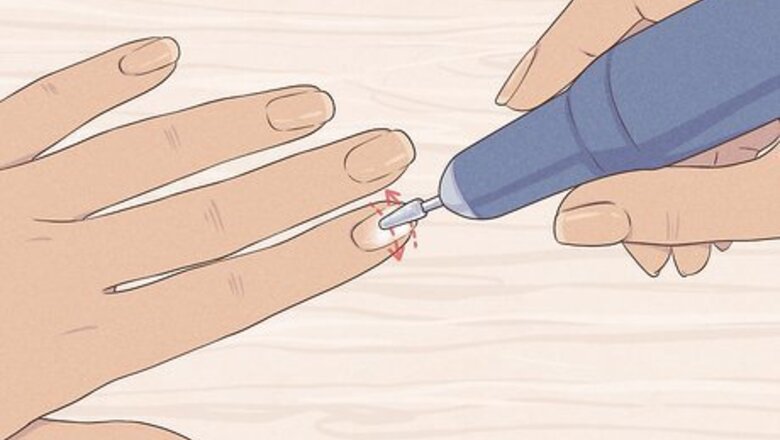
views
- Coat your nails with a thin layer of primer and a base coat of builder gel after roughing them up with a file. Apply nail forms or artificial tips to add extensions.
- Spread the builder gel in an even layer so it’s thickest near the center of each nail. Cure the nails under an LED light or UV lamp for 1–2 minutes.
- Shape the tips of your nails with a file. Finish up by applying a top coat or gel nail polish and curing it for 1–2 minutes.
Buff and clean your nails.
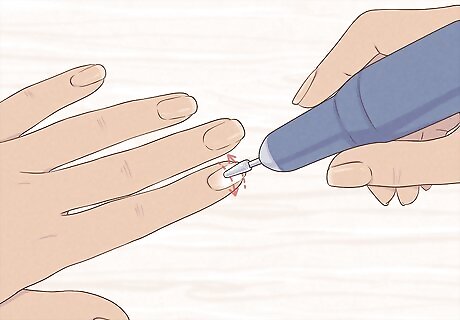
Buffing your nails helps the builder gel stick better. Take an electric buffer and run it horizontally across the tops of your nails. Press down lightly to start buffing just above your cuticles and work toward the tips of your nails. Only move the buffer in a single direction to remove the shine from your nails’ surface. After you roughen up all of your nails, brush off any nail dust and wipe them with a lint-free pad wet with isopropyl alcohol so you have a clean starting surface. If you forget to buff your nails before applying builder gel, then dust could get trapped under the gel and weaken the bond to your nail.
Coat a layer of primer on your nails.
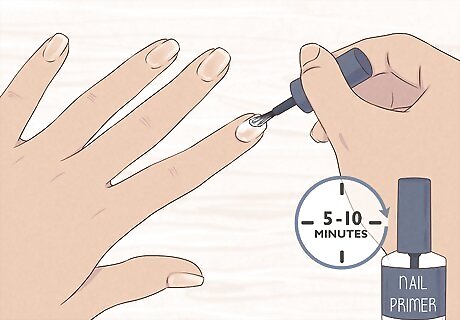
Nail primer prevents gels from lifting off of the surface. Dip your nail brush into the bottle of primer and dab it onto your nails. Spread the primer into a thin even layer over each of your nails from the base to the tip. Then, let the primer air-dry on your nails for about 5–10 minutes. Nail primer helps remove any of the remaining oils or moisture on your nails so the builder gel adheres evenly.
Apply and cure a thin layer of builder gel as a base coat.
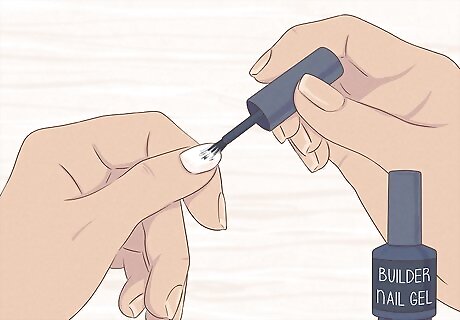
A base coat acts as a protective layer between the gel finish and your nails. Dip your brush in the builder gel you’re using and dab it onto the center of each nail. Lightly float the brush over your nail to spread the base coat in a thin layer over the nail. Once you finish applying the gel, hold your hand upside-down for about 10 seconds for the gel to smooth out. Then, cure your nails under an LED lamp for 30 seconds, or a UV lamp for 2 minutes depending on what light is listed on the gel’s packaging. Most builder gels come with a built-in brush attached to the cap. If your builder gel doesn’t have an attached brush, then use a paintbrush instead. Base coats may be optional depending on the builder gel you’re using. Read the instructions on the packaging to see if they recommend applying a base coat or not. Curing times may vary for different builder gels, so always follow the directions on the packaging so they harden properly.
Attach nail forms or artificial tips for extensions.
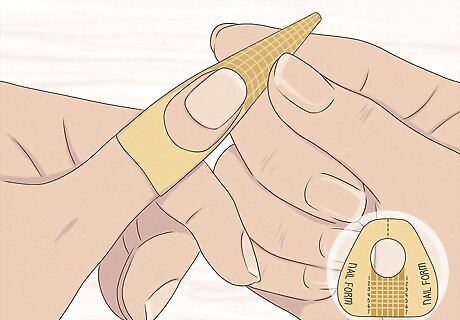
Nail forms and artificial tips help you add more length to your nails. Nail forms are paper or plastic templates that wrap around your finger and shape gel nail extensions. Bend the form to match the curve of your nail and tuck the edge underneath the end of your nail. Stick the bottom flaps of the form together to secure it to your finger. If you’re applying nail tips, paint nail glue onto the edge of the tip and gently press it onto the surface of each nail for about 5 minutes until they’re dry. Using nail forms lets you build extensions off of your natural nails so you don’t have to attach artificial tips. If you apply artificial tips, then file the edges down so they’re even with your natural nail so they don’t create a visible line.
Spread and cure builder gel on your nail tips and forms.
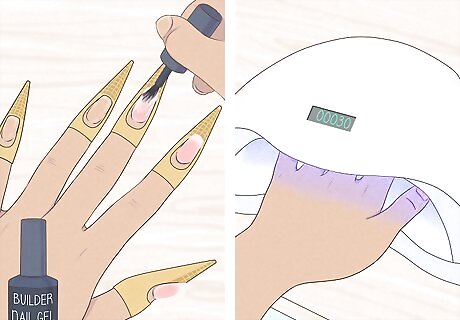
Starting on your nail tips lets you lengthen and shape your nails. Dip your nail brush into the builder gel you’re using, and dab a bead onto the tip of your nail where it meets the nail form. Slowly pull the brush along the form out to the length that you want for your nail. Spread the gel into an even layer over the nail form. Once you’re happy with the length and shape of all your nails, hold them under an LED or UV lamp to cure for the time listed on the packaging. If you’re only applying builder gel to your natural nail or artificial nail tips, then skip this step. Once you cure your nail tips, remove the forms by pinching them together and slowly pulling them off.
Apply a full coat of builder gel to your nails and cure them.
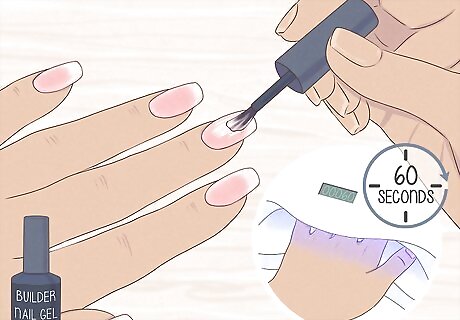
Covering your nail with builder gel creates a smooth finished surface. Dab more builder gel onto your nail with your brush. Gently move the brush in a circular motion from the cuticle out to the tip, making the gel slightly thicker near the middle of your nail. Apply your builder gel to all of your nails before curing them under an LED lamp for 60 seconds or a UV lamp for around 2 minutes. Builder gel will stay wet until you cure it, so continue spreading it until you’re happy with the shape and thickness. Be careful not to get any builder gel on your skin since it could cause the nails to lift and come off.
Wipe your nails with an alcohol pad.
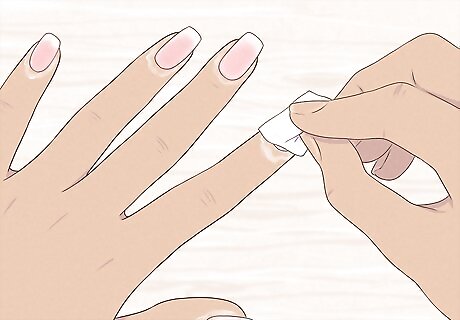
Alcohol breaks down the tacky top film left over on your nails. Gently rub the surface of your gel nails with your alcohol pad so they don’t feel sticky anymore. That way, dust and dirt won’t get stuck as you start filing and shaping your nails. If you don’t have alcohol pads, then just wet a cotton ball with isopropyl alcohol and run it over your fingernails.
Shape your nails with a file.
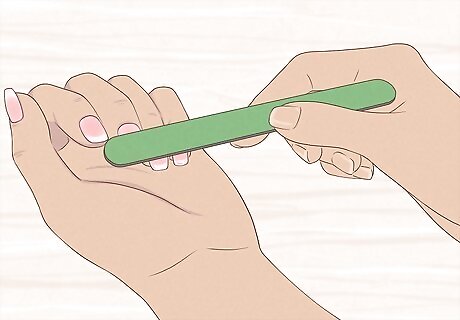
Refine the rough edges of the builder gel until your nails look uniform. Once the builder gel has cured, it may look a little thick or misshapen on your nail. Rub the edges and tops your nails with a medium file with long strokes in a single direction. Continue working the file until the tips of your nails curve downward and so the gel is the thickest near the center of your natural nail. If there are raised bumps on the surface of your nails, file them down as well so they’re smooth. To help shape and file your nails quicker, use an electric buffer to shave down the gels until they have a smooth appearance.
Finish with a top coat or color gel polish.
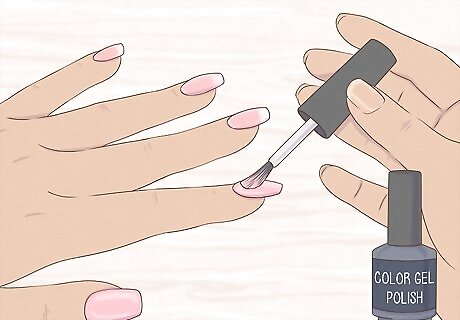
A top coat gives your nails a smooth, attractive finish. If you want to maintain the clear, natural look of your nails, then spread the top coat from your cuticle to the tip of your nail with a brush. Alternatively, try using thin layers of gel nail polish to add pops of color to your nail instead. No matter what you use, cure your top coat of gel polish with a UV or LED lamp for the recommended time listed on the packaging, which is usually 1–2 minutes. Gel nail polish is different than builder gel since it’s applied in thin layers and made to add color. Builder gel on the other hand uses a thicker application that’smade for strengthening and extending your nails.
Rub cuticle oil into the bases of your nails.
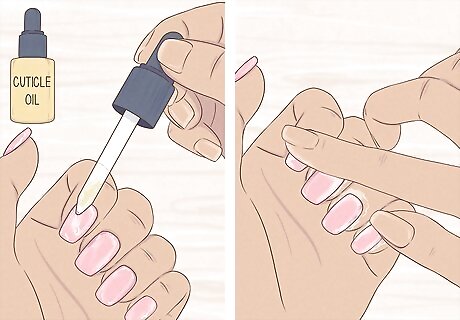
Cuticle oil helps moisturize skin around your nails so they stay healthy. Apply your cuticle oil by painting a thin layer onto the base of your nails where they meet your skin. Gently massage the oil into your cuticles for a few minutes until it’s completely absorbed into your skin. Cuticle oil also helps prevent your cuticles from getting damaged or cracked, which could let bacteria into your body.
Touch up your nails after 2–3 weeks.
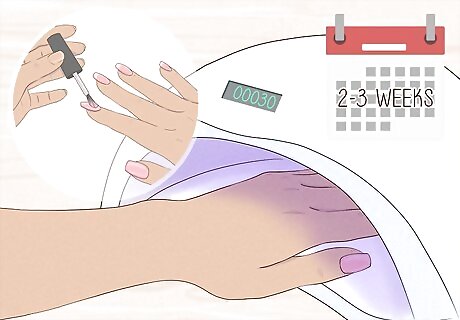
Filling in your nails helps hide where you natural nail grew in. After 2–3 weeks, your nails will have grown out and may be exposed next to your cuticles. File down the surface of your gel nails to rough up the surface, and apply primer to the exposed natural nail. Coat the surface of your nail with a thin, even layer of builder gel, focusing on the natural nail near your cuticle. Once the gel looks smooth, cure it under an LED or UV lamp for the time listed on the package. Alternatively, file the builder gel down with an electric buffer if you want to remove it completely and start again from your natural nail.

















Comments
0 comment